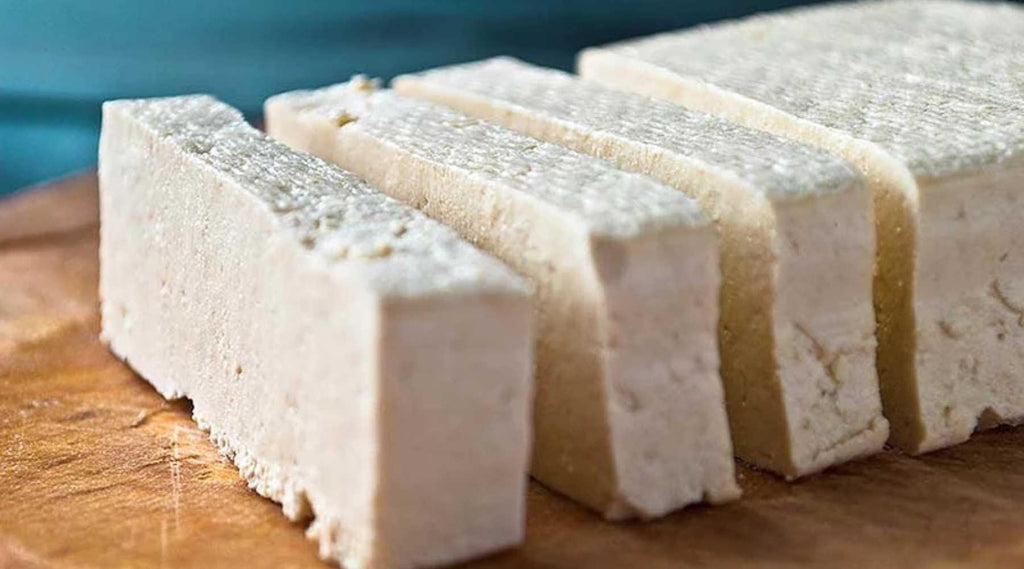
There’s only one way to describe tofu… a vegan’s best friend. Vegan tofu has been a cornerstone of the plant-based diet since day 1, and, whether you like it crispy, battered, or scrambled, there is no better ingredient for jugging up your meals than this humble soy-bean protein.
But, vegan tofu can get sometimes a bad rep… Meat-lovers will often say that eating tofu is no better for the environment than eating meat. The bad news is that in some ways, this is true. Tofu isn’t perfect and producing soy may produce similar levels of CO2 as producing meat.
However, vegans, don’t panic! This is not the whole story. The good news is that, on the whole, vegan tofu is actually way better for the environment than meat, and also way better for you! Here’s why…
Why Is Vegan Tofu Bad For The Environment?

As we mentioned, unfortunately, vegan tofu isn’t perfect when it comes to environmental impact. This is not down to soy itself, but instead the way it is often grown.
To produce soy, rainforests are often clear-cut to create farmland so it can be grown on a mass scale. This deforestation means that there are fewer trees on our planet to absorb CO2. And, as we know, more CO2 means bad things for the climate.
Is Vegan Tofu Better For The Environment Than Meat?
A big fat yes! Why? Because - plot-twist - the biggest consumer of soy is actually the meat industry! Yep, we are serious. Meat-eaters are often the first to critique vegan tofu because of the environmental impacts of soy production, however, actually, according to a study by the University of Illinois, 98% of the soy grown worldwide ends up in animal stomachs. That’s right, the majority of the world’s soy production is actually used to feed livestock for meat production!
Also, tofu is actually produced using fewer soybeans than it takes to produce the same amount of meat. For example, one kilo of soybeans will produce two kilos of tofu, as opposed to just 300 grams of pork!
Ready for some more good news? Meat production also uses more land and produces more methane gas than soy does, making tofu come up trumps again!
Are Some Tofus Better For The Planet Than Others?
If you are really keen to minimize environmental impact, then our top tip is to pay attention to which tofu you are buying. The tofu you buy in the shops can be genetically modified, which may be less good for you and the planet.
However, the good news is that manufacturers in the US have become more aware that GM is not what everyone wants- and they are doing something about it. So, as non-GMO products become more and more popular, non-GMO tofu becomes more and more common!
Not only that, but it is also really easy to buy organic vegan tofu, which is specially made to have the best impact on you and the planet. This is because organic produce says no to using harmful pesticides, artificial chemicals, or fertilizers! Pretty neat, right?
What Are The Health Benefits Of Vegan Tofu?
So, what else is great about tofu? As well as being better for the planet than meat production, tofu also has some amazing health benefits that really knock meat out of the park.
Made from soybeans, tofu is always gluten-free, contains 0 cholesterol (unlike meat), and is a killer source of protein fur us vegans!
The cherry on top of the cake? Vegan tofu also contains loads of isoflavones. This means that eating tofu may be linked to reducing the risk of all sorts of diseases, including cardiovascular disease and osteoporosis. So, now we have a few more excuses to scoff lots of delicious tofu!!
Can You Make Tofu From Scratch?
Yes! Making homemade vegan tofu is surprisingly easy. We recently made our own tofu and it was 100% worth the extra effort. The taste and textures you get are much better than store-bought tofu, and the best part is – you know exactly what is in it! Soybeans, lemon, and water, that's it!
Vegan Tofu Recipe:

Ingredients:
- 100 grams (0.2lbs) of soybeans
- Water
- Lemon juice or vinegar
Equipment:
- Blender
- Pot
- Bowl
- Measuring cup
- Mesh Bag or cloth
- Fine strainer
1) Soak the soybeans
Soak the soybeans in water overnight. The water should completely cover the beans. It takes around eight to ten hours for the beans to absorb the water. After they've finished soaking, you can pour out the rest of the water.
2) Blend and cook the soybeans
Add 350 milliliters (12oz) of water to the soaked soybeans and blend the whole mixture until a mushy liquid is formed. Cook the mix in a pot for around 10 minutes on a high heat.
3) Filter the soybeans
After the soy liquid has cooled down, put a mesh bag or cheesecloth into a strainer and place it over a bowl. Next, pour the soy liquid over the strainer and allow it to drain into the bowl. You can then wring the cloth over the bowl to remove excess fluid. The filtered liquid is now your soy milk! The excess solids are called okara, or soy pulp. Now you can begin processing the tofu.
4) Mix the soy milk with lemon juice or vinegar
Add 3-4 tablespoons of lemon juice or vinegar to the soy milk. The soy milk will curdle immediately as the protein separates from the whey. The acid flocculates the soy milk. Let the milk stand for about ten minutes so that the acid mixes evenly throughout; stirring is not necessary. In case the soy milk is not correctly flocculated, add a little bit more of the lemon juice or vinegar. No worries, you won't taste it afterward.
5) Filter the tofu mass
Place a cotton cloth or cheesecloth over a fine strainer. Place the strainer with the cloth on top of a bowl. Tilt the soy, lemon, vinegar mixture through the cotton cloth so that the whey is separated. Let the mixture drain well. You can give it a helping hand by pulling the ends of the cloth together and gently squeezing the liquid out from top to bottom. But be careful and don't press too hard. We want to ensure the mixture does not squeeze out of the cloth. At this point, you should have a paste or mushy mass of tofu left on your cloth that you can season as you like.
6) Press the tofu mass and enjoy
Place some weight on top of your tofu mass to help shape and press it into a more compact form. You can do this for up to an hour. After pressing, your tofu is ready for cooking. Enjoy!



